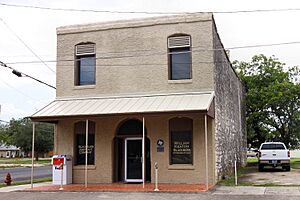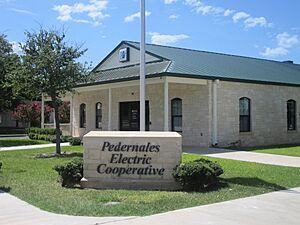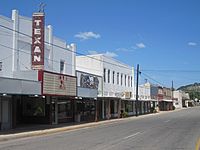Junction, Texas facts for kids
Quick facts for kids
Junction, Texas
|
|
|---|---|
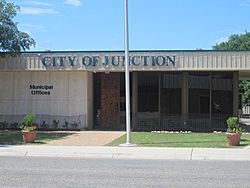
Junction City Hall
|
|
| Nickname(s):
Land of Living Waters, Front Porch of the West
|
|
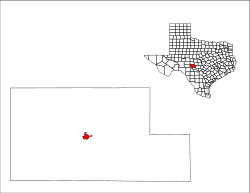 |
|
| Country | United States |
| State | Texas |
| County | Kimble |
| Area | |
| • Total | 2.30 sq mi (5.96 km2) |
| • Land | 2.29 sq mi (5.94 km2) |
| • Water | 0.01 sq mi (0.02 km2) |
| Elevation | 1,709 ft (521 m) |
| Population
(2020)
|
|
| • Total | 2,451 |
| • Density | 1,065.7/sq mi (411.2/km2) |
| Time zone | UTC-6 (Central (CST)) |
| • Summer (DST) | UTC-5 (CDT) |
| ZIP code |
76849
|
| Area code(s) | 325 |
| FIPS code | 48-38248 |
| GNIS feature ID | 2410156 |
| U.S. Routes | |
| Interstates | |
Junction is a city in Kimble County, Texas, United States. It is also the county seat, which means it's where the main government offices for the county are located. In 2020, about 2,451 people lived there.
Contents
Where is Junction, Texas?
Junction is located in the middle of Kimble County, Texas. It's about 115 miles northwest of San Antonio and 140 miles west of Austin.
Interstate 10 runs through the northern and eastern parts of the city. This highway connects Junction to other cities like Kerrville and Sonora. Other important roads like U.S. Route 83 and U.S. Route 377 also pass through Junction.
The city gets its name because it's located where two rivers meet. These are the North and South Llano Rivers. This meeting point is called a "confluence."
The Story of Junction
Junction started in 1876. It was first called "Denman" after the person who planned the town. But the name quickly changed to "Junction City."
Later in 1876, Junction City became the county seat for Kimble County. This was a big deal! By 1879, the town had stores, a stable, and a sawmill. About 300 people lived there in 1882. The first newspaper in Kimble County also started in 1882.
The county courthouse burned down in 1884. A new one was built, but it was also damaged by fire in 1888. It was fixed and used until 1929, when the current courthouse was built. In 1894, "Junction City" became just "Junction."
In the 1890s, the town got better services. A businessman named Ernest Holekamp helped bring water to the city in 1895. A dam was built on the South Llano River in 1896. This dam provided power and water for the city and nearby farms.
The population grew to 536 by 1900. A bigger dam, Four Mile Dam, was finished in 1904. By 1920, about 1,250 people lived in Junction.
In 1927, the people of Junction decided to officially become a city with its own government. Ernest Holekamp was elected as Junction's first mayor.
In the 1920s, new highways connected Junction to other towns. A sewer system was built in 1929. By 1930, the city had 1,415 residents. Junction became a main center for trade and tourism. It was also a popular place for hunting.
New city buildings were opened in 1939 and 1940. In the 1940s, the cedar-oil business helped the economy. Since then, Junction's population has stayed around 2,600 people.
People of Junction
| Historical population | |||
|---|---|---|---|
| Census | Pop. | %± | |
| 1890 | 449 | — | |
| 1930 | 1,415 | — | |
| 1940 | 2,086 | 47.4% | |
| 1950 | 2,471 | 18.5% | |
| 1960 | 2,441 | −1.2% | |
| 1970 | 2,654 | 8.7% | |
| 1980 | 2,593 | −2.3% | |
| 1990 | 2,654 | 2.4% | |
| 2000 | 2,618 | −1.4% | |
| 2010 | 2,574 | −1.7% | |
| 2020 | 2,451 | −4.8% | |
| U.S. Decennial Census | |||
What the 2020 Census Shows
| Race | Number | Percentage |
|---|---|---|
| White (NH) | 1,563 | 63.77% |
| Black or African American (NH) | 5 | 0.2% |
| Native American or Alaska Native (NH) | 9 | 0.37% |
| Asian (NH) | 32 | 1.31% |
| Pacific Islander (NH) | 1 | 0.04% |
| Some Other Race (NH) | 8 | 0.33% |
| Mixed/Multi-Racial (NH) | 48 | 1.96% |
| Hispanic or Latino | 785 | 32.03% |
| Total | 2,451 |
In 2020, there were 2,451 people living in Junction. These people lived in 1,091 households. About 661 families called Junction home.
City Services and Roads
Junction is served by major highways like Interstate 10, U.S. Route 83, and U.S. Route 377.
The Kimble County Airport has a paved runway that is 5,000 feet long. You can fly to and from Mathis Field in San Angelo from here.
Electric power for Junction comes from AEP/West Texas Utilities. The Pedernales Electric Cooperative provides power to the areas outside the city.
The community is kept safe by a police force and county sheriff officers. A volunteer fire department with 30 members helps fight fires. There are also ambulance and rescue services available.
Learning in Junction
Public schools in Junction are part of the Junction Independent School District. The district has an elementary, middle, and high school. All these schools are on one campus.
Junction is also home to the Texas Tech University Center at Junction. This is a branch of Texas Tech University. It's a large campus that offers many different college programs.
Famous People from Junction
Some well-known people have connections to Junction:
- Les Cox, a former professional baseball player.
- Clinton Manges, a businessman from South Texas.
- Andrew Murr, a current Republican member of the Texas House of Representatives.
- Coke Stevenson, who was the governor of Texas from 1941 to 1947, was born in Junction.
Fun Things to Do in Junction
Junction has fun events like the Billie Sale and Parade in August. Another event is the annual Kimble Kow Kick in September.
You can visit the Kimble County Historical Museum. It has old tools, documents, and items from early settlers. The O.C. Fisher Museum is in the Kimble County Library. It has a copy of the office of a famous congressman who represented the Junction area.
Junction has several parks, including the large South Llano River State Park. The city also has swimming pools, golf, and tennis courts. There are many hotels and motels because it's located along Interstate 10. The Fort McKavett State Historic Site is also close to Junction.
Junction's Weather
The weather in Junction has hot, humid summers. Winters are usually mild to cool. It has a humid subtropical climate.
| Climate data for Junction, Texas, 1991–2020 normals, extremes 1897–present | |||||||||||||
|---|---|---|---|---|---|---|---|---|---|---|---|---|---|
| Month | Jan | Feb | Mar | Apr | May | Jun | Jul | Aug | Sep | Oct | Nov | Dec | Year |
| Record high °F (°C) | 90 (32) |
98 (37) |
100 (38) |
104 (40) |
114 (46) |
111 (44) |
109 (43) |
112 (44) |
108 (42) |
104 (40) |
93 (34) |
91 (33) |
114 (46) |
| Mean maximum °F (°C) | 80.0 (26.7) |
82.7 (28.2) |
88.5 (31.4) |
93.6 (34.2) |
98.9 (37.2) |
100.9 (38.3) |
102.0 (38.9) |
102.8 (39.3) |
98.0 (36.7) |
93.0 (33.9) |
84.4 (29.1) |
79.8 (26.6) |
104.4 (40.2) |
| Mean daily maximum °F (°C) | 62.0 (16.7) |
66.0 (18.9) |
73.2 (22.9) |
81.0 (27.2) |
86.7 (30.4) |
92.8 (33.8) |
95.6 (35.3) |
95.8 (35.4) |
89.0 (31.7) |
81.0 (27.2) |
69.8 (21.0) |
62.5 (16.9) |
79.6 (26.5) |
| Daily mean °F (°C) | 45.8 (7.7) |
49.9 (9.9) |
57.5 (14.2) |
65.1 (18.4) |
73.1 (22.8) |
79.9 (26.6) |
81.9 (27.7) |
81.6 (27.6) |
74.8 (23.8) |
65.2 (18.4) |
54.4 (12.4) |
46.5 (8.1) |
64.6 (18.1) |
| Mean daily minimum °F (°C) | 29.5 (−1.4) |
33.8 (1.0) |
41.8 (5.4) |
49.2 (9.6) |
59.5 (15.3) |
66.9 (19.4) |
68.3 (20.2) |
67.5 (19.7) |
60.5 (15.8) |
49.5 (9.7) |
38.9 (3.8) |
30.4 (−0.9) |
49.7 (9.8) |
| Mean minimum °F (°C) | 14.4 (−9.8) |
17.2 (−8.2) |
21.5 (−5.8) |
29.5 (−1.4) |
41.6 (5.3) |
56.1 (13.4) |
61.1 (16.2) |
58.9 (14.9) |
45.8 (7.7) |
30.6 (−0.8) |
20.7 (−6.3) |
15.4 (−9.2) |
11.5 (−11.4) |
| Record low °F (°C) | −4 (−20) |
−5 (−21) |
5 (−15) |
21 (−6) |
29 (−2) |
38 (3) |
49 (9) |
44 (7) |
32 (0) |
21 (−6) |
9 (−13) |
−11 (−24) |
−11 (−24) |
| Average precipitation inches (mm) | 0.90 (23) |
1.28 (33) |
2.04 (52) |
1.96 (50) |
2.73 (69) |
2.56 (65) |
1.52 (39) |
1.89 (48) |
2.73 (69) |
2.87 (73) |
1.35 (34) |
1.19 (30) |
23.02 (585) |
| Average snowfall inches (cm) | 0.1 (0.25) |
0.0 (0.0) |
0.0 (0.0) |
0.0 (0.0) |
0.0 (0.0) |
0.0 (0.0) |
0.0 (0.0) |
0.0 (0.0) |
0.0 (0.0) |
0.0 (0.0) |
0.2 (0.51) |
0.1 (0.25) |
0.4 (1.01) |
| Average precipitation days (≥ 0.01 in) | 3.5 | 3.9 | 4.8 | 3.6 | 4.8 | 3.9 | 4.1 | 4.4 | 4.6 | 4.1 | 3.9 | 4.0 | 49.6 |
| Average snowy days (≥ 0.1 in) | 0.1 | 0.0 | 0.0 | 0.0 | 0.0 | 0.0 | 0.0 | 0.0 | 0.0 | 0.0 | 0.2 | 0.0 | 0.3 |
| Source 1: NOAA | |||||||||||||
| Source 2: National Weather Service | |||||||||||||
See also
 In Spanish: Junction (Texas) para niños
In Spanish: Junction (Texas) para niños




